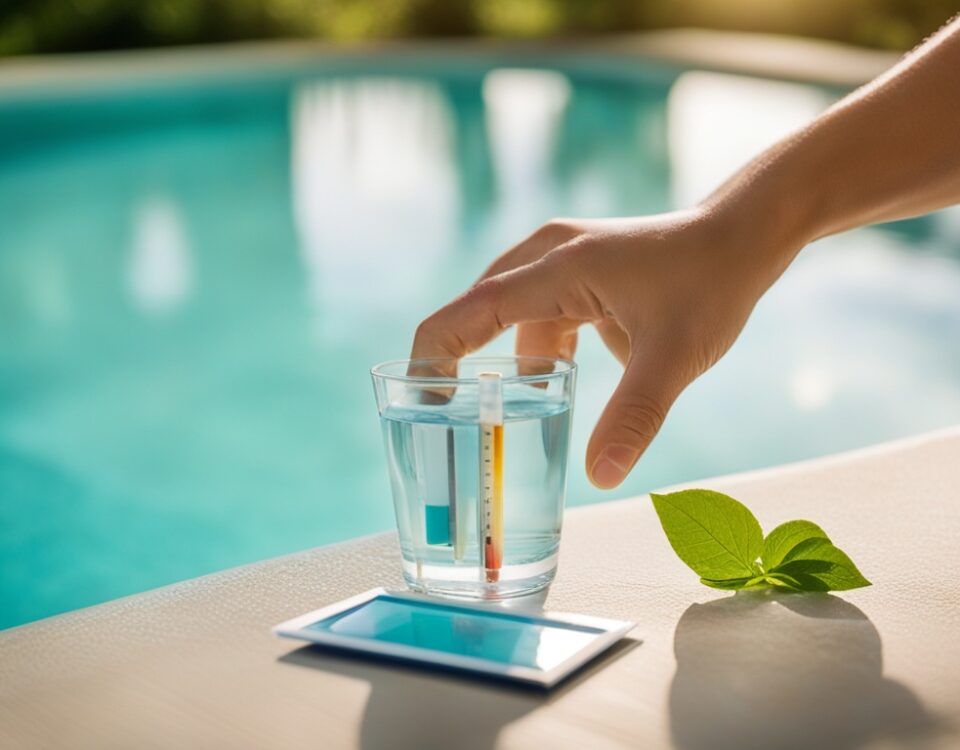5 Lightning-Fast Ways to Revive a Green Pool!

Master the Art of DIY Pool Building with These Expert Tips
May 15, 2025
Unlock Crystal Clarity: Mastering Pool Water Testing
May 16, 2025Understanding the Causes of a Green Pool
To effectively tackle the problem of a green pool, one must first understand the underlying causes that contribute to this unsightly condition. This phenomenon is often the result of algae growth, which can flourish in a poorly maintained swimming pool environment.
Algae Growth
Algae are microscopic organisms that thrive in warm, stagnant water. When a pool’s chemical balance is disrupted, algae can quickly proliferate, leading to a greenish hue. Factors such as inadequate sanitization and nutrient-rich water provide the perfect breeding ground for these unwanted guests. Left unchecked, algae can rapidly take over, creating not only an unsightly appearance but also posing health risks to swimmers.
pH Imbalance
A significant contributor to green pools is a pH imbalance. The pH level indicates how acidic or basic the water is. Ideally, your pool’s pH should be between 7.2 and 7.6. When pH levels rise above this range, it can hinder the effectiveness of chlorine, the primary sanitizer used to keep pool water clean. An inadequate pH level leads to inadequate disinfection, allowing algae and other contaminants to flourish.
Inadequate Filtration
The filtration system plays a crucial role in maintaining clear and clean pool water. If the filtration system is inadequate or malfunctioning, it will not effectively remove debris, organic matter, and algae. A pool that lacks proper filtration can become stagnant, leading to a welcoming environment for algae to thrive. Regular maintenance and timely replacement of filter components are essential to prevent such occurrences.
Lack of Circulation
Circulation is another pivotal factor in preventing a green pool. When water is not circulated properly, certain areas of the pool become stagnant, which allows algae to grow. The use of pool pumps and skimmers is vital in ensuring that water flows consistently throughout the pool. Proper circulation not only aids in the distribution of chemicals but also helps in maintaining water clarity and hygiene.
The Importance of Addressing Root Causes
Merely treating the symptoms of a green pool by adding chemicals or shocking the water without addressing the root causes is a futile endeavor. Understanding and rectifying issues such as algae growth, pH imbalance, inadequate filtration, and lack of circulation is crucial for not just temporary cleaning, but for sustainable pool maintenance. By focusing on these underlying factors, you can create an environment that is not only appealing but also safe for all swimmers.
| Cause | Impact on Pool | Solution |
|---|---|---|
| Algae Growth | Green tint, health risks | Regular chlorination |
| pH Imbalance | Reduced sanitizer effectiveness | Use pH increaser or decreaser |
| Inadequate Filtration | Debris and contaminants build-up | Maintain or upgrade filter |
| Lack of Circulation | Stagnation, algae proliferation | Ensure effective pump operation |
Assessing the Severity of the Green Pool Issue
When confronted with a green pool, the first step lies in conducting a thorough visual inspection to gauge the pool’s water clarity and color. Look closely at the water surface; a vibrant green hue typically indicates an excessive presence of algae. If the water appears cloudy or murky, it signals that the pool’s filtration system is likely compromised, and the water is not moving effectively. Moreover, if the pool possesses any debris, such as leaves or twigs, this can exacerbate the growth of algae, complicating the cleaning process.
Water Chemistry: The Key to Clarity
Subsequent to the visual inspection, the importance of testing the pool’s water chemistry cannot be overstated. Utilize a reliable water testing kit to ascertain the levels of chlorine, pH, and alkalinity. The ideal free chlorine level is typically between 1-3 ppm (parts per million). If your readings fall below this range, it indicates a failure to kill the algae effectively. For pH, a range of 7.2-7.6 is optimal; imbalances can hinder chlorine’s efficacy, leading to persistent algae growth. Lastly, alkalinity should reside between 80-120 ppm; this helps stabilize pH levels. Here is a simple reference table for quick clarity:
| Water Parameter | Ideal Range |
|---|---|
| Free Chlorine | 1-3 ppm |
| pH | 7.2-7.6 |
| Alkalinity | 80-120 ppm |
Immediate Action vs. Routine Maintenance
Upon assessing both the visual state and chemical balance of your pool, determining whether immediate action is required becomes paramount. If your inspection reveals a deep emerald hue, coupled with highly imbalanced chemical readings, quick intervention is necessary to prevent further algae proliferation. This often entails shock treating the pool with a significant dose of chlorine alongside vigorous vacuuming and scrubbing.
Conversely, if the water exhibits a light green tint or mild cloudiness, and the chemical levels are within acceptable ranges, routine maintenance might suffice. A consistent regimen that includes regular brushing, vacuuming, and appropriate chemical adjustments can gradually restore your pool’s clarity without the need for drastic measures. However, remain vigilant; neglecting even a minor green hue can swiftly escalate the problem.
Ultimately, understanding the severity of the green pool dilemma allows owners to tailor their response effectively. By performing a meticulous assessment and adjusting maintenance tactics accordingly, you can reclaim the pristine allure of your swimming sanctuary.
Gathering the Necessary Cleaning Equipment and Supplies
Cleaning a green pool swiftly and efficiently requires an organized approach. Ensuring you have the right cleaning equipment and supplies is paramount to avoid unnecessary delays and frustrations during the process. Below is a comprehensive list of essential tools you will need:
- Pool Skimmer: This device is indispensable for removing leaves, debris, and other floating contaminants from the surface of the water.
- Pool Brush: Utilize a sturdy brush with a telescopic pole to scrub the walls and floor of your pool, breaking up algae and grime.
- Automatic or Manual Vacuum: A vacuum will help eliminate dirt and algae settled on the bottom of the pool, providing a crisp and clean finish.
- Water Testing Kit: Investing in a reliable kit is crucial for assessing the chemical balance of your pool water, enabling you to take appropriate corrective measures.
- Hose: A high-quality garden hose can assist in filling the pool or rinsing off cleaned equipment.
Eco-Friendly Cleaning Products
For those looking to maintain an environmentally-conscious approach to pool maintenance, it is vital to select eco-friendly cleaning products. These products not only reduce the environmental impact but also safeguard the health of your family and pets. Consider using the following:
- Biodegradable Algaecides: These natural agents effectively combat algae without introducing harmful chemicals into your pool.
- Natural Enzymes: Enzyme-based cleaners break down organic matter and can assist in achieving clear water.
- P-H Balancers: Look for natural alternatives that help stabilize pH levels without harsh chemicals.
By choosing eco-friendly options, you not only promote a sustainable lifestyle but also contribute to the longevity of your pool and the surrounding ecosystem.
Before you commence the cleaning process, it is critical to gather all your supplies in one place. An organized workstation will significantly enhance your efficiency, saving valuable time and effort. Utilize a bucket or storage container to keep everything readily accessible, reducing the likelihood of interruptions throughout your cleaning session. This preparation allows for a seamless transition from one task to the next, ultimately ensuring that your green pool becomes a pristine oasis in no time.
Draining and Refilling the Pool (if necessary)
In certain situations, draining your pool becomes a necessary step in restoring it from the grips of green water. The extent of the problem is typically determined by water chemistry levels and the severity of algae growth. If you find that your pool water is not only green but also exhibits exceedingly high levels of chlorine, phosphates, or stabilizers, or if the algae infestation is so profound that it cannot be effectively treated through traditional means, draining may be your only recourse.
When to Drain the Pool
The decision to drain your pool hinges on a few critical factors:
- Chlorine Levels: If your free chlorine levels exceed 10 parts per million (ppm), it may be ineffective for treatment.
- pH Levels: An imbalanced pH reading (below 7.2 or above 7.8) can inhibit proper disinfection and obscure visibility.
- Severity of Algae: Heavy infestations might require complete removal of the water, especially if discoloration persists after treatment attempts.
Step-by-Step Instructions for Draining the Pool
- Check Local Regulations: Before proceeding, ensure compliance with local laws, as certain areas have restrictions on draining.
- Prepare Your Equipment: Obtain a submersible pump, drainage hose, and a filtration system if necessary.
- Power Off Equipment: Turn off all pool-related equipment, including filters and heaters, to prevent damage.
- Begin Pumping: Position the submersible pump at the deepest end of the pool, connecting it to an appropriate drainage hose. Begin the pumping process, monitoring the discharge area to prevent flooding.
- Monitor Water Levels: Regularly check the water level while draining to gauge the progress accurately.
- Flush the Pool Surface: Once drained, consider rinsing the pool surface to eliminate any residual algae or debris.
Refilling Your Pool
After successfully draining the pool, it’s time to move on to the refilling process. Here’s how to ensure a smooth refill:
- Inspect Pool Equipment: Before you start refilling, check the pool’s plumbing, filtration system, and walls for any signs of wear or leaks.
- Select the Water Source: Use either a garden hose or a water delivery service, depending on your needs. Using tap water is typical, but ensure that it’s free of contaminants.
- Monitor Water Chemistry: As the pool fills, periodically check the water chemistry. You’ll want to adjust pH and alkalinity levels as needed.
- Consult Local Guidelines on Discharge: Should you be draining into a storm drain or sewer, verify that it’s permissible according to local environmental regulations.
- Balance Water Chemistry: Once the pool is filled, perform a thorough water balance test to adjust chlorine, pH, alkalinity, and calcium hardness levels to conform to optimal values.
By methodically following these steps, you can not only achieve a clearer pool but also ensure that your pooling experience remains enjoyable and safe.
Shocking the Pool and Balancing Chemicals
To tackle the persistent problem of a green pool, one must comprehend the significance of shocking the water. Shocking is the process of adding a large dose of chlorine or other chemical agents to eliminate algae, bacteria, and other contaminants that thrive in murky waters. This act serves as a crucial first step in reviving your pool’s vitality and clarity.
The Importance of Shocking
When a pool turns green, it’s often due to a combination of inadequate sanitation and an overload of organic material. By shocking the pool, you effectively oxidize these impurities, leading to a rapid decrease in algae and bacteria levels. Moreover, this process helps to recirculate chemicals within the pool, enhancing their effectiveness in maintaining a hygienic environment for swimmers.
How to Shock Your Pool
Next, let’s delve into the technique of properly shocking your pool based on its size and condition. Here’s a simple guide:
| Pool Size (Gallons) | Recommended Chlorine Shock (lbs) | Type of Shock |
|---|---|---|
| 10,000 | 1-2 | Calcium Hypochlorite |
| 20,000 | 2-4 | Calcium Hypochlorite |
| 30,000 | 3-6 | Sodium Dichloro-S-Triazine-Trione |
| Above 30,000 | 4-8 (adjust as necessary) | Sodium Dichloro-S-Triazine-Trione |
Follow these steps to ensure an effective shock treatment:
- Test the Water: Begin by measuring your pool’s pH and chlorine levels using a test kit. Aim for a pH of 7.2 to 7.6 before shocking.
- Prepare the Shock: Based on the size of your pool, measure out the appropriate amount of shock treatment. Always refer to the product’s instructions for precise measurements.
- Dilute if Necessary: For granular shock, mix it with water in a bucket before adding it to the pool. This ensures even distribution and minimizes potential damage to the pool surface.
- Add the Shock: Pour the shock solution evenly around the perimeter of the pool while the pump is running. This aids in complete circulation.
- Allow to Circulate: Let the pool pump run for at least 24 hours, allowing the shock to work its magic. After this period, retest the water before swimming.
Balancing Chemicals
After shocking your pool, the journey doesn’t end there. It’s imperative to balance the chemicals in your pool to prevent future occurrences of murky waters. Regularly check your chlorine levels, ideally between 1-3 parts per million (ppm), with a total alkalinity of 80-120 ppm, and a pH level of 7.2-7.6. Proper chemical balance not only enhances swimmer comfort but also ensures the longevity of your pool equipment.
Striving for this balance creates an inhospitable environment for algae growth, thus safeguarding your pool against future malaise. By adhering to this diligent regimen, you will not only enjoy a crystal-clear pool but also a healthy swimming experience for you and your loved ones.
Scrubbing and Cleaning the Pool Surfaces
Cleaning a green pool is an essential task that begins with the meticulous scrubbing of all surfaces, including the walls, floors, and corners, to effectively remove stubborn algae buildup. The process starts with gathering the appropriate tools: a pool brush, a telescopic pole, and a vacuum. By connecting a brush to the telescopic pole, you can reach those hard-to-access areas while applying necessary pressure to dislodge the algae that may have clung to the surfaces over time.
Manual scrubbing is not only about scrubbing but also entails paying close attention to areas that often harbor algae, such as the corners and steps. Begin at the waterline and work your way down, using long, sweeping strokes to cover larger areas efficiently. Adjust the brush’s direction to ensure that you cover all angles, as algae thrive in hidden spots. This thorough approach is vital for achieving a clean and inviting swimming environment.
Tips for Effective Scrubbing
To maximize the effectiveness of your scrubbing efforts, select a brush with stiff bristles designed for your specific pool surface—whether it be vinyl, fiberglass, or plaster. This ensures you can properly penetrate and scrub away the algae without damaging the pool. For best results, move systematically from one side of the pool to the other, allowing any debris dislodged during scrubbing to settle at the bottom.
Incorporating a pool vacuum into your cleaning arsenal significantly enhances the quality of the clean. Automated or manual vacuums can efficiently capture the debris loosened during scrubbing. A well-maintained vacuum will ensure that no particles or algae remain suspended in the water, allowing for an overall pristine pool. Be sure to follow manufacturer guidelines when operating the vacuum to achieve optimal suction and efficiency.
The Importance of Regular Maintenance
It’s crucial to understand that scrubbing is not merely a remedial task but an integral part of regular pool maintenance. Establishing a cleaning routine where you scrub the surfaces at least once a week will dramatically decrease the likelihood of algae growth. Incorporating chemical treatments, such as algaecides and chlorine, into a consistent maintenance schedule further fortifies your defenses against potential algae blooms, contributing to a consistently sparkling clean pool.
For those looking to enhance their maintenance strategy, consider the following table to record and track your routine cleaning schedule:
| Date | Task Completed | Next Scheduled Cleaning |
|---|---|---|
| [Date] | Scrubbing, Vacuuming | [Next Date] |
| [Date] | Chemical Balance Check | [Next Date] |
| [Date] | Filter Cleaning | [Next Date] |
In conclusion, a proactive approach to scrubbing and cleaning your pool surfaces not only helps in swiftly tackling existing algae but also prevents future occurrences, ensuring a safe and pleasurable swimming environment for all. Consistency in these practices is key to maintaining your oasis sparkling and inviting.
Maintaining a Clean and Green Pool
In order to preserve the clarity and inviting nature of your pool, establishing a robust maintenance regimen is paramount. A clean pool not only enhances aesthetics but also ensures the safety and health of its users. By implementing proactive measures, you can effectively thwart the resurgence of that dreaded green hue caused by algae blooms and other contaminants.
Regular Water Testing
One of the cornerstones of effective pool maintenance is consistent water testing. This process involves regularly checking the chemical levels—especially pH, chlorine, alkalinity, and cyanuric acid. A well-balanced pool environment discourages algae growth and promotes overall water safety. Aim to test your pool water at least once a week during peak swimming seasons; this diligence will help you adjust chemical levels before they escalate into a more significant issue.
Filtration System Checks
Your pool’s filtration system is its first line of defense against murky waters. Routine inspections of the filter system ensure that it is functioning optimally. Clean or replace your filter as necessary, and verify that your pump is running efficiently, ideally for 8 to 12 hours a day. Neglecting the filtration system can lead to a build-up of debris, promoting algal growth and compromising water quality.
Cleaning Schedule
Establishing a cleaning schedule is essential for maintaining a pristine pool environment. Regularly skimming the surface, vacuuming the pool floor, and brushing the walls will eliminate debris before it forms a breeding ground for algae. Make it a habit to inspect the skimmer and pump baskets weekly, removing any accumulated leaves or grime. A dedicated cleaning day, perhaps set for weekends, ensures that these tasks become a consistent part of your pool care routine.
Sustainable Cleaning Practices
To create a sustainable cleaning routine, consider utilizing eco-friendly pool care products that minimize chemical usage while still delivering effective results. Enzyme-based cleaners can assist in breaking down organic matter, while natural algaecides can combat algae without introducing harsh chemicals. Additionally, incorporating a regular cycling schedule for pool maintenance—balancing chemical treatments with physical cleaning—will promote a clearer swimming environment.
| Maintenance Task | Frequency | Notes |
|---|---|---|
| Water Testing | Weekly | Adjust chemical levels as needed. |
| Filter Inspection | Monthly | Clean or replace as necessary. |
| Surface Skimming | Daily | Remove leaves and debris. |
| Vacuuming | Weekly | Focus on the pool floor. |
| Brushing Walls | Bi-weekly | Prevent algae growth on surfaces. |
By adhering to these ongoing maintenance practices, you can ensure that your pool remains a shimmering oasis rather than a green nuisance. Investing the time in regular upkeep will create a vibrant and welcoming space, maximizing your enjoyment and health while minimizing future cleaning challenges.
Learn more about Maintenance & Cleaning

Javier Morales is passionate about pool design, maintenance, and outdoor living. With years of hands-on experience, he offers practical tips, creative ideas, and expert insights to help readers make the most of their pool spaces. At Piscina Planet, Javier shares everything from seasonal care guides to the latest trends in pool innovation.




